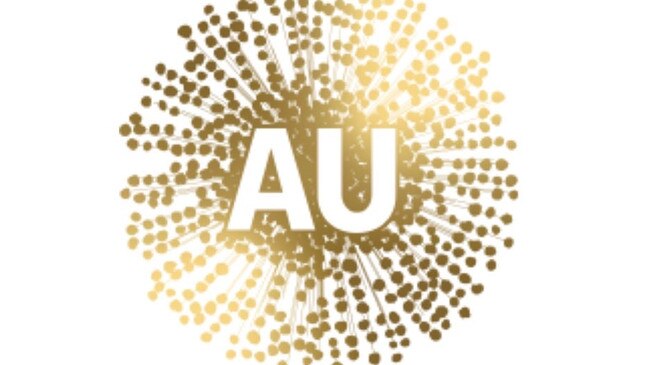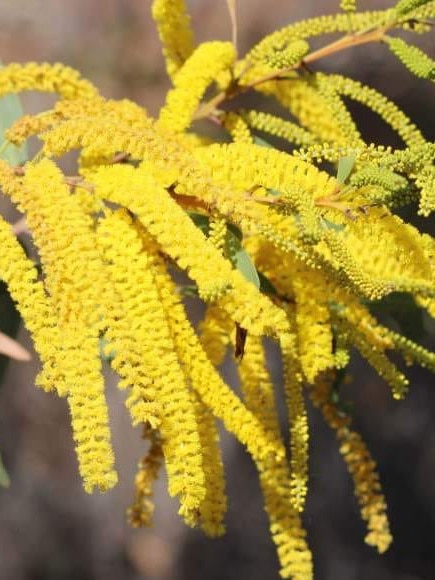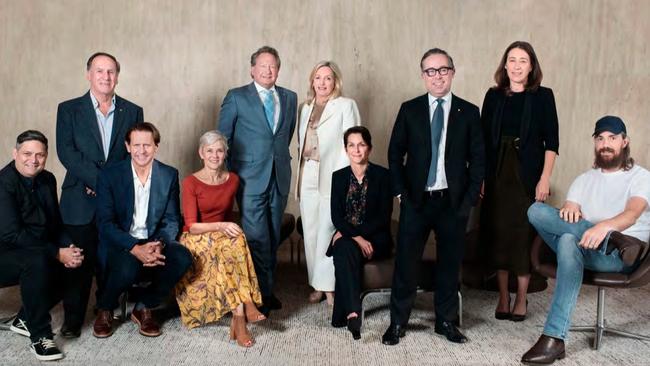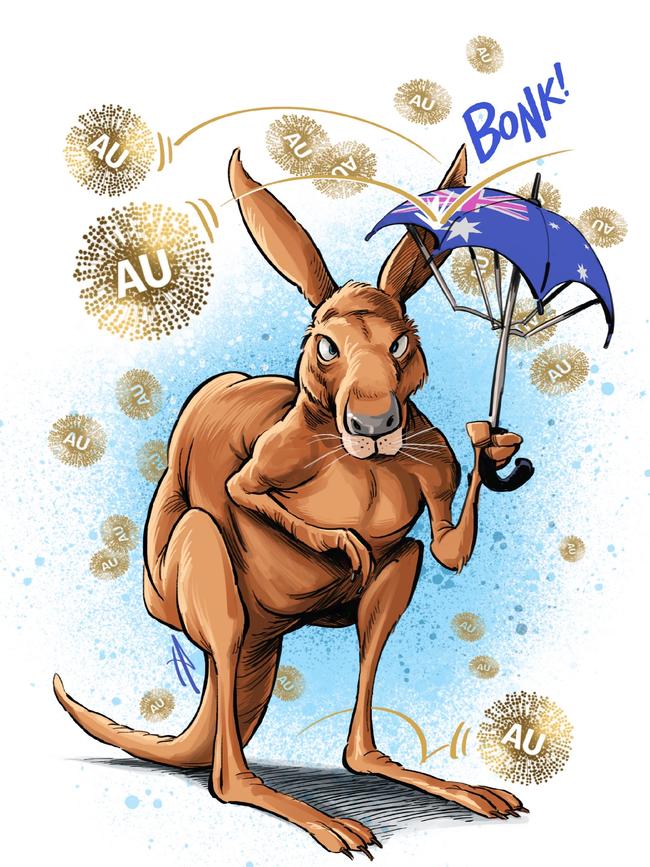Miranda Devine: Nation Brand are wrong to propose replacing the kangaroo with wattle as Australia’s national symbol
What happens when you get a self-serving mining billionaire whose fortune depends on the Chinese Communist Party to help rebrand Australia? A national symbol that looks like a COVID-19 cell, writes Miranda Devine.
A panel of wealthy elites, including Twiggy Forrest, Alan Joyce and Mike Cannon-Brookes, secretly decided to jettison the beloved kangaroo as Australia’s national symbol and replace it with an abstract image of a wattle that looks like a yellow COVID-19 virus cell.
Talk about bad timing. To be fair, in December, when the “Nation Brand” advisory council presented its final design to the government, the virus had only quietly started to circulate in Australia. They weren’t to know they were advocating that Australia rebrand as a killer virus.
The council, chaired by mining magnate Forrest, was authorised in 2018 by former PM Malcolm Turnbull with $10 million to create a new national identity to market to the rest of the world.

It seemed like a good idea at the time, since the Department of Foreign Affairs and Trade felt Australia’s branding had become fragmented, with “no unified representation of the country internationally”, according to its 2017 White Paper, which cited New Zealand’s “100% Pure” as a model.
But, as ever, the devil was in the detail.
Leaving the running to a self-serving mining billionaire whose fortune depends on the Chinese Communist Party was always going to be a problem, pre-pandemic.
Today, Forrest’s project is a fiasco.
Whether it looks like a coronavirus cell, a yellow snowflake, a gold disco ball, or an ink splodge, there is nothing remotely Australian about the logo, let alone appealing.
Instead it appears designed as a blank canvas to appeal to a Chinese market.
While the design was “market tested” to 16,000 people in seven countries, headed by China, and over 300 CEOs, only 53 Aussie consumers were consulted.
“The design could well be Austria,” says NSW One Nation leader Mark Latham, “a $3 million waste of money creating confusion internationally.
“In light of the Wuhan virus, it’s now plain embarrassing as it looks like a representation of COVID-19.
“It’s a complete fiasco that should be chucked in the bin.”
Rather than retaining the traditional kangaroo logo which appears in our coat of arms, the council chose a stylised spherical blob representing a wattle flower rendered in gold dots.
Unlike New Zealand’s black fern or Canada’s maple leaf, the wattle blob is amorphous and generic.
In fact, the council’s report warns “the word ‘Australia’ should appear under the mark at all times to … avoid misinterpretation”.


There would be no misinterpretation if we used our recognisable and unique kangaroo, because the rest of the world has known what it represents since a 1773 account of Captain Cook’s first voyage to the Pacific.
“We love our kangaroo — it is currently the most internationally recognised shortcut to Australia,” says the report, presented to the government in December.
But, perversely, the kangaroo’s instant recognition factor was judged a negative because it would “simply reinforce what people already knew about us”.
The other black mark against Skippy was that “dual-branding situations of multiple kangaroos sitting side-by-side will not work”.
But who said every kangaroo has to be exactly the same?
The flying kangaroo does not give Qantas jets a monopoly on what has been a beloved national symbol for two centuries.
The council chose the wattle, hoping, “while not immediately recognisable internationally, it will become so over time”.
The Morrison government accepted all the council’s recommendations, including the new logo and changing the current national slogan, “Australia Unlimited” to “Only In Australia”.
In a letter to the council created on June 16, Trade Minister Simon Birmingham wrote: “The Australian government has … accepted the recommendations of the Advisory Council.
“The new Nation Brand predates the global pandemic (but) it will be a critical part of the recovery.”
However, yesterday, the Prime Minister was having it both ways.
“Whether it’s the green and gold kangaroo or some extra new way of standing out, the world is going to know what buying Australian means,” he said in a statement.
Birmingham also walked back his enthusiasm for the blob yesterday afternoon, saying: “Kangaroos will continue to be a key part of Australia’s marketing.
“The Nation Brand … will simply seek to bring some consistency in how different government agencies, industry bodies, states and territories present themselves.”
So much for a unifying symbol.

There are two toxic threads to this branding exercise.
First is the embedded Year Zero ideology.
The council chose the wattle as a “a blank canvas, to tell a new Australian story”.
But why does Australia need a “new story”?
We’re not a blank canvas for other cultures to impose their views. As radicals in the West try to erase history, this is a signal to our foes that we no longer value our history, culture and tradition.
The brand also is designed to impose a “framework” on “the way the country talks about itself”.
Good luck with that.
The report tells us the aim is to “shift perceptions of our nation”.
Is there a problem we don’t know about?
Australia has a good reputation overseas, enhanced by our response to the pandemic.
In America, Australians are widely admired, in my experience.
The only people who wring their hands about Australia’s international reputation are China panderers and self-flagellating leftists who constantly find fault with our national identity, history, flag and system of government and bemoan a lack of cultural sophistication in the masses.

Sure, Australia’s reputation is on the nose at present in China, but that’s because our government rightly has stood up to the CCP by demanding an inquiry into the origins of COVID-19.
In return, China has threatened us, placed boycotts on our exports, left our ships idling off shore, sent its agents into parliament House to spy on us, and is widely believed to be the state-based actor responsible for hacking critical infrastructure.
As Forrest knows well, symbolism is everything in China, and the symbol he is serving up, rendered in gold, symbolises wealth, riches and nobility.
Even if it ends up as yellow, since metallic inks are expensive and clog up high-speed printers, that is the Chinese royal colour (incidentally the least popular colour in the West). Since when did the democratically elected government outsource our identity to a self-serving oligarch?
Secondly is the catchline ‘Only In Australia’, which the report calls a “storytelling platform”.
The phrase has a derogatory connotation in its most common usage “Only in America” always said with the roll of the eye. This is an open invitation to trolling which the council seems not to have considered.
Let’s shelve the wattle blob and save our kangaroo.
Miranda Devine is in New York for 18 months to cover current affairs for The Daily Telegraph
